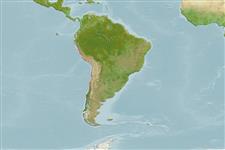Elasmobranchii (Haie und Rochen) (sharks and rays) >
Carcharhiniformes (Ground sharks) >
Atelomycteridae (Coloured catsharks)
Etymology: Schroederichthys: In honor of American ichthyologist William C. Schroeder (1895-1977), Woods Hole Oceanographic Institution, for his pioneering work (with Henry B. Bigelow) on cartilaginous fishes; ichthyos (Gr.), fish. (See ETYFish); chilensis: -ensis, Latin suffix denoting place: Chile, described from the Pacific of Chile (and Peru). (See ETYFish).
More on author: Guichenot.
Environment: milieu / climate zone / depth range / distribution range
Ökologie
seewasser demersal. Subtropical; 9°S - 51°S
Southeast Pacific: Peru and Chile.
Size / Gewicht / Alter
Maturity: Lm ? range ? - ? cm
Max length : 62.0 cm TL Männchen/unbestimmt; (Ref. 244)
An inshore shark found on the continental shelf. Oviparous (Ref. 50449). Sexual dimorphism is evident in dentition of male species (Ref. 49562).
Life cycle and mating behavior
Maturities | Fortpflanzung | Spawnings | Egg(s) | Fecundities | Larven
Oviparous, paired eggs are laid. Embryos feed solely on yolk (Ref. 50449). Males have longer teeth with fewer cups than females (Ref. 51093) to make 'courtship biting' more effective (Ref. 49562).
Compagno, L.J.V., 1984. FAO Species Catalogue. Vol. 4. Sharks of the world. An annotated and illustrated catalogue of shark species known to date. Part 2 - Carcharhiniformes. FAO Fish. Synop. 125(4/2):251-655. Rome: FAO. (Ref. 244)
IUCN Rote Liste Status (Ref. 130435)
Bedrohung für Menschen
Harmless
Nutzung durch Menschen
Fischereien: nicht kommerziell
Tools
Zusatzinformationen
Download XML
Internet Quellen
Estimates based on models
Preferred temperature (Ref.
123201): 10.2 - 13.2, mean 11.3 °C (based on 40 cells).
Phylogenetic diversity index (Ref.
82804): PD
50 = 0.5312 [Uniqueness, from 0.5 = low to 2.0 = high].
Trophic level (Ref.
69278): 3.5 ±0.5 se; based on diet studies.
Widerstandsfähigkeit (Ref.
120179): sehr niedrig, Verdopplung der Population dauert mehr als 14 Jahre. (Fec=2).
Fishing Vulnerability (Ref.
59153): Moderate vulnerability (45 of 100).
Nutrients (Ref.
124155): Calcium = 27.5 [4.5, 149.5] mg/100g; Iron = 0.744 [0.202, 2.283] mg/100g; Protein = 15.9 [13.0, 20.3] %; Omega3 = 0.205 [0.091, 0.441] g/100g; Selenium = 25.5 [7.7, 71.1] μg/100g; VitaminA = 10 [3, 28] μg/100g; Zinc = 0.657 [0.315, 1.206] mg/100g (wet weight);
